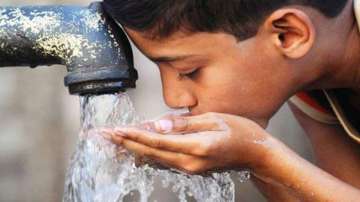94.5% families in villages, 97.5% in cities used 'improved drinking water' in Jul-Dec 2018: Report
The NSO, a wing of the Ministry of Statistics and Programme Implementation, has conducted a survey on drinking water, sanitation, hygiene and housing condition as a part of 76th round (July–December 2018) of National Sample Survey (NSS).

As many as 94.5 per cent families in rural areas and 97.5 per cent in cities used 'improved drinking water' from sources including tube wells, tankers and piped supply during July-December 2018, showed a National Statistical Office (NSO) survey report on Saturday.
The NSO, a wing of the Ministry of Statistics and Programme Implementation, has conducted a survey on drinking water, sanitation, hygiene and housing condition as a part of 76th round (July–December 2018) of National Sample Survey (NSS).
According to the study, about 94.5 per cent families in villages and about 97.4 per cent in cities used improved source of drinking water viz. bottled water, piped water into dwelling, piped water to yard/plot, piped water from neighbour, public tap/standpipe, tube well, hand pump, protected well, public tanker truck, private tanker truck, protected spring and rainwater collection.
It showed that the major source of drinking water was hand pumps for households in rural areas and piped water into a dwelling in the urban areas.
About 42.9 per cent families in rural areas used hand pump as the principal source of drinking water and about 40.9 per cent in cities used piped water into the dwelling as the principal source of drinking water.
About 48.6 per cent families in villages and about 57.5 per cent in cities had exclusive access to the principal source of drinking water.
It also said that about 87.6 per cent families in villages and about 90.9 per cent in cities had sufficient drinking water throughout the year from the principal source.
About 58.2 per cent families in villages and about 80.7 per cent in cities had drinking water facilities within the household premises.
About 51.4 per cent families rural and about 72 per cent in the urban areas used an improved source of drinking water, sufficiently available throughout the year located on the premises.
In terms of bathroom and sanitation facility, the report showed that about 50.3 per cent families in villages and about 75 per cent in cities had exclusive access to the bathroom.
About 56.6 per cent families in villages and about 91.2 per cent in cities had access to the bathroom.
Among the households which had access to the bathroom, about 48.4 per cent villages and about 74.8 per cent in the urban areas used bathroom attached to the dwelling unit.
The survey also showed that about 71.3 per cent families in villages and about 96.2 per cent cities had access to a latrine.
It may be noted that there may be respondent bias in the reporting of access to latrine as the question on benefits received by families from government schemes was asked prior to the question on the access of households to the latrine, it added.
The major type of latrine used by the households was flush/pour-flush to the septic tank in both rural and urban areas.
About 50.9 per cent families in villages in rural and 48.9 per cent in urban areas used flush/pour-flush to septic tank type of latrine.
Among the households which had access to a latrine, about 94.7 per cent of the males and 95.7 per cent of the females in villages used latrine regularly while about 98 per cent of the males and 98.1 per cent of the females in cities used latrine regularly.
About 3.5 per cent of family members in villages and about 1.7 per cent in cities never used a latrine. About 4.5 per cent in villages and 2.1 per cent in cities reported that water was not available in or around the latrine used.
About 48 per cent families in villages and about 86.1 per cent in cities had bathroom and latrine both within household premises.
On the tenurial status and household characteristics, it said that about 96 per cent families in villages and 63.8 per cent cities had their own dwelling unit.
Among families living in houses, about 76.7 per cent in villages and about 96 per cent in cities had pucca structure. The average floor area of dwelling unit was about 46.6 square metre in villages and about 46.1 square metre cities.
Among families living in houses, about 93.9 per cent in villages and 99.1 per cent in cities had electricity for domestic use. About 48.3 per cent in villages and about 86.6 per cent in cities used LPG as fuel for cooking.
Similarly, 61.1 per cent families in villages and about 92 per cent in cities had a drainage system in the house. About 48.1 per cent families in villages disposed off household wastewater without treatment to open low land areas/streets. In cities, about 71.1 per cent families disposed of off household wastewater without treatment to the drainage system.
About 72.4 per cent in villages disposed of household garbage either in household’s individual dumping spot or in a commonplace other than community dumping spot. In cities, the proportion is 70.3 per cent.
Similarly, 80.4 per cent of families in villages had no arrangement for collection of household garbage. In cities, panchayat/municipality/corporation made arrangement for collection of household garbage for about 74.1 per cent families.
About 87.1 per cent families in villages and about 95.7 per cent cities had the house with a direct opening to approach road/lane/constructed path.
ALSO READ | People are 'terrified' to drink water supplied in the city: Manoj Tiwari to Arvind Kejriwal
ALSO READ | Central ministers playing 'dirty politics' by saying drinking water in Delhi poisonous: Arvind Kejriwal